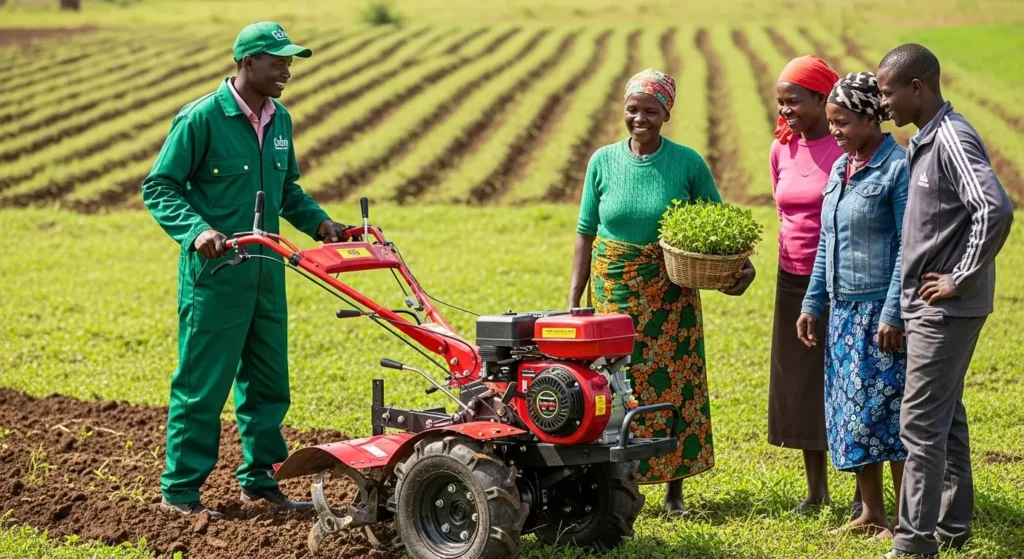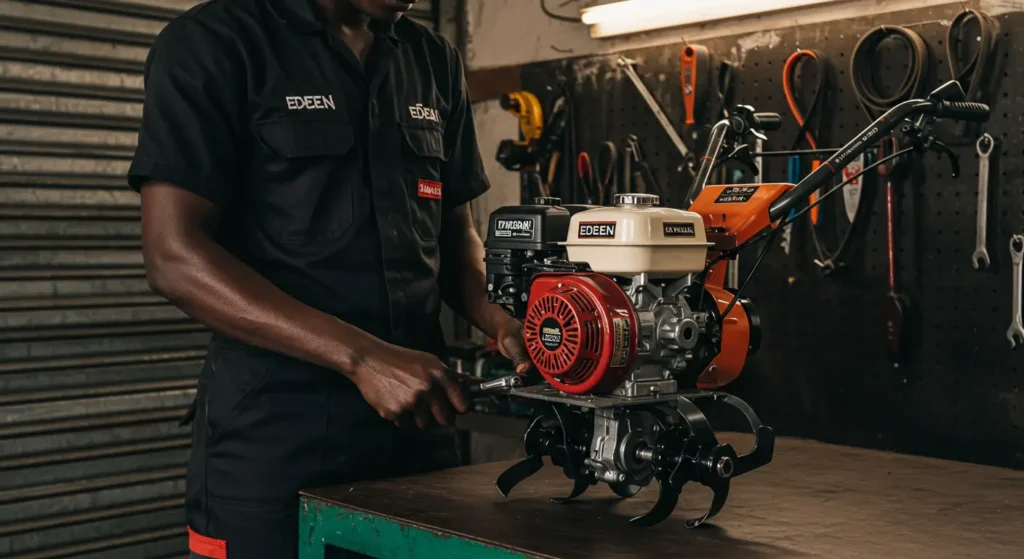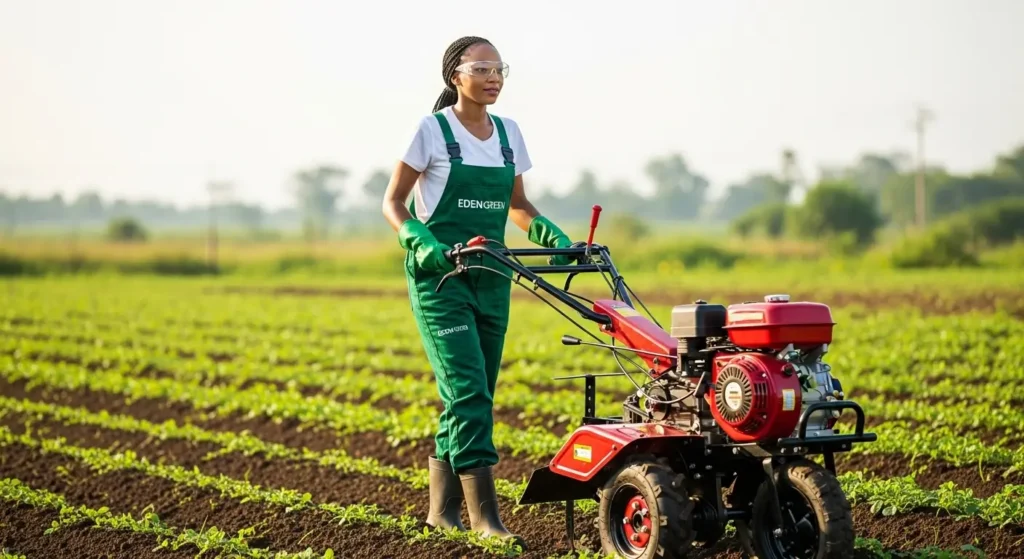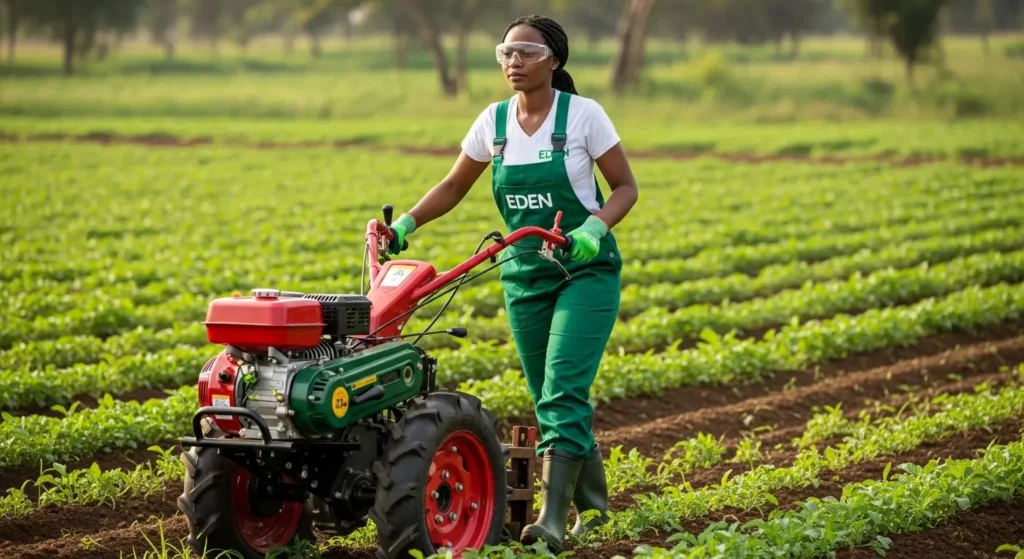When Mama Naserian walked the narrow track to her two‑acre shamba outside Kajiado, she carried a small tin of fuel and a list of chores that usually took a week. That morning she borrowed a neighbour’s walking tractor, a compact, two‑wheel machine and by noon the land was neatly ridged, ready for planting. The work that once stole her strength and time had been turned into a few focused hours. She left with a small stack of bookings from neighbours and a plan to offer tilling as a paid service during the next planting season.
This guide is written for that farmer, the young operator thinking of starting a land‑preparation service, the women’s group exploring income activities and the project manager designing a practical mechanization intervention.
What is a power tiller (hand‑tractor)?
A power tiller also called a hand-tractor, walking-tractor or “two-wheel tractor” in Kenya is a compact, engine-driven machine you guide from behind. Its engine drives rotating tines, wheels and sometimes a PTO shaft, so one unit can:
- rotavate (or rototill) the soil;
- plough or turn heavy ground;
- build ridges and furrows;
- haul a small trailer or carry seedlings/inputs;
- drive an irrigation pump or other PTO capability.
For small farms, youth-run tillage services or mechanization-led agribusinesses, the power tiller is the most affordable entry into mechanized agriculture: cheaper to buy than a full 4-wheel tractor, easier to maintain and far better matched to small plots and fragmented land. (See the core guide at Eden offers.)
Who benefits and how (practical scenarios)

Consider three people in the same sub-county:
- A smallholder farmer with half an acre of vegetables uses a machine to rid the land, save time, reduce weeding and plant in perfect beds.
- A young couple decides to launch a land-preparation service: they buy one machine, fix an hourly rate, add fuel/spares cost and build micro-business income.
- A women’s group shares a machine across multiple plots: they pool capital, schedule usage, build a maintenance fund and unlock reliable rural income.
Mechanization is not just about speed, it’s about timeliness, labour predictability, planting windows and giving women and youth access to income-generating assets.
Types and horsepower and how to match machine to land

Power tillers come in a range of sizes and engine types. Choosing the right size is less about brand and more about matching power to the soil, the implements you’ll use and how many hours per season the machine will run. At Eden Lawn & Garden Centre you’ll find both petrol and diesel options.
While many service-providers in Kenya lean diesel for durability and fuel economy, petrol models still have a good place for smaller plots, lighter soils or less frequent use.
Here’s a refined decision matrix:
| Land size / use | Soil/terrain | Recommended engine power & fuel type | Why |
|---|---|---|---|
| < 1 acre, household use, light soil | loamy, well-tilled ground | 6-8 HP petrol or light diesel | Light machine, easy to operate, low cost. |
| ~1-3 acres, small business/service, mixed soil | moderate soil, occasional trailer or ridger | 10-12 HP | Versatile, can attach rotavator + trailer. |
| > 3 acres / service provider / heavy soil / daily use | heavy clay or compacted, many hours per week | 12-15 HP diesel or more (15-25HP+) | Diesel gives durability and better fuel economy. |
Tailored tip: If your client (for example your youth agripreneurs) plans to run a service for other farmers (tillage + haulage) or expects rough terrain / heavy soil, lean toward the 12-15 HP or higher diesel option. If the target is a small orchard/neighborhood plot, a petrol (or lighter diesel) unit may suffice and gives faster ROI.
Implements and attachments – turning one machine into many
The magic of a tiller is the attachment system. With the right implements a single machine becomes a rotavator for seedbeds, a ridger for potatoes, a trailer for small haulage and a pump driver for irrigation. Common implements include:
- Rotary tillers (rotavators): Break clods and prepare fine seedbeds; they save hours of manual hoeing.
- Mouldboard or disc ploughs: For turning heavier soils before the rains; they require more engine power and a sturdier gearbox.
- Ridgers and furrowers: Build ridges for root crops and furrow irrigation; indispensable for many vegetable and tuber systems.
- Small trailers (carts): Turn the tiller into a transport unit for seedlings, inputs or harvests.
- Pump drives and PTO implements: Use the engine to run irrigation pumps or seeders where a PTO is available.
- Trailer: For transporting farm produce and other inputs where ordinary truck may not reach.
When planning purchases, think of a base machine plus two or three high‑value implements that match your core cropping system – for example, rotavator + ridger + trailer for mixed vegetable or potato enterprises.
How to choose the right tiller

Before you buy, answer these practical questions in full sentences and write them down. They will save money and time:
• What is the typical size of the land you will work and what soil type is it? Heavy, compacted soils need more HP and robust gearboxes.
• How many hours per week will the machine run? Daily service providers need industrial‑grade gear and easy‑access spares.
• Which implements do you plan to use most of the season? If you will use rotavators and trailers, choose at least 12 HP.
• Who will operate and maintain the machine? Budget for hands‑on training and a simple maintenance routine-that reduces breakdowns.
• Where will you get spares and service? Buy from a supplier who stocks common parts and provides assembly and field support.
Answering these helps you pick a specific model instead of guessing by price.
Maintenance, operation and safety to keep it running longer

A small maintenance routine extends useful life and protects the operator. After every shift clean clods from the tines and remove plant debris. Check oil, belts and fasteners weekly during peak use. Change engine oil as the manual recommends (many machines ask for a short initial service and then regular intervals), and inspect gearbox oil and tines seasonally.
Operators should always wear closed shoes, avoid loose clothing, and stop the engine before adjusting tines or changing implements.
Simple guards, proper rigging of trailers and hands‑on training make the difference between an expensive accident and a safe, productive machine.
Practical procurement & financing approaches (for groups and projects)
Buying a machine isn’t just “line-item” — it’s a strategic investment. Some practical steps:
- Supplier added-value: At Eden we deliver, assemble, commission on-site and provide spares & maintenance support.
- Define usage: how many hours/week? How many acres? Soil type?
- Implements? Build a basic business model: hourly rate, fuel cost, spare-part reserve, operator cost.
- Shared ownership model: co-ops/groups can pool funds, schedule usage, build a reserve for maintenance, track income from tillage service.
Eden’s end‑to‑end offering (what we provide)
At Eden Lawn & Garden Centre we deliver machines, assemble them, commission them on site and provide operator training tailored to your crop and terrain. We hold a stock of common spares and offer scheduled maintenance and repairs. For community projects and start‑up service providers we prepare a starter kit: a recommended machine with two priority implements, a spare parts bag and a half‑day hands‑on training session to get the operator confident and the machine running reliably.
If you would like a quote for a starter kit – machine, implements, spares and on‑site training, our sales team can prepare a tailored package with delivery and commissioning included.
Quick decision guide
If your priority is household plots and easy handling, choose a 6-8 HP petrol or diesel mini‑tiller. If you plan to offer paid tillage and use trailers or heavier rippers, choose 12-15 HP diesel for durability and fuel economy. For heavy daily commercial use or deep ploughing, select 15 HP and above with reinforced gearboxes and industrial‑grade components.
Frequently asked questions
Will a power tiller save money compared with hiring a tractor? For small plots and dispersed farms, yes power tillers are cheaper to run per hour and can be deployed quickly. On many hectares, a four‑wheel tractor still makes sense.
Are these machines easy to operate for women and youth? Absolutely. With proper training and the right horsepower, operators of varied ages and sizes can safely run hand‑tractors. Many service models deliberately train young operators and women to create income opportunities.
What about fuel and running costs? Diesel models are generally more fuel efficient and durable for continuous work; petrol models suit lighter, irregular use. Include spare parts and a simple maintenance schedule in any running‑cost estimate.
What about petrol vs diesel-? Indeed. While diesel dominates for heavy/tillage work, petrol models are very viable for smaller plots or where diesel access is limited. Make sure to ask Eden which petrol models they carry, what HP rating and what implements fit.
How to choose between petrol and diesel for youth agribusiness? If your model is: service work, many hours, heavy soil → lean diesel. If it’s: household plots, lighter soil, young operator, fewer hours → petrol could be more cost-effective up front and simpler.
Ready to see one work?

If you’re building a youth agribusiness (like your partnership at the AGC Model Farm) or equipping female-led groups, now is the moment to act. Pick the right machine from Eden, let the operator learn, let the machine pay for itself—and let the story of “from fuel tin and hoe” turn into “engine whirr and income stream.”
Come down to Teco Mall on Mombasa Road, take a look at the machines, test the tiller, ask to see the implements and ask for the starter-kit quote from Eden’s team. Make the choice that transforms your land and your business.







